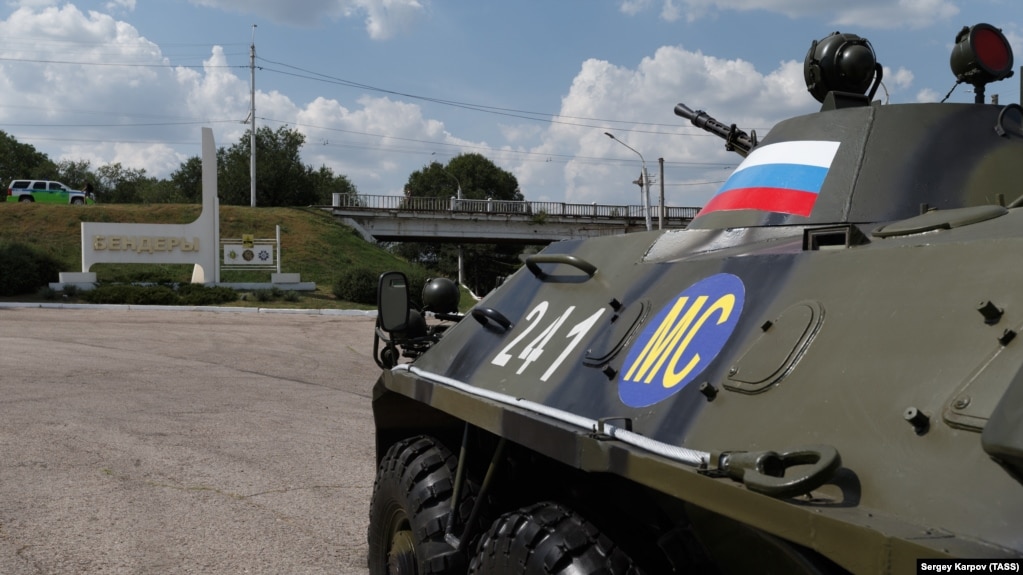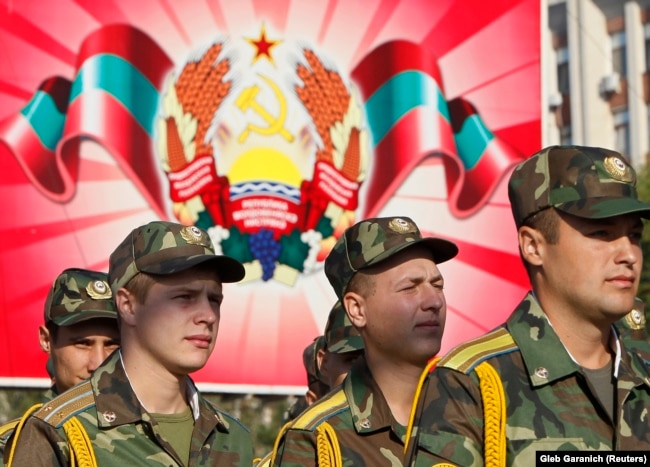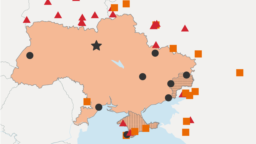February 15, 2022
By Tony Wesolowsky

For decades, Russia has had more than 1,000 troops in Transdniester, a breakaway region of Moldova, and Ukrainian officials are wary.
Ukraine is on edge as it faces what analysts call the greatest buildup of military forces in Europe in decades.
Russia has nearly encircled Ukraine, deploying an estimated 130,000 troops and military hardware on three fronts: in Crimea to the south, on the Russian side of the two countries' border, and in Belarus to the north.
Rarely mentioned, however, is the small contingent of Russian troops on Ukraine's southwestern border.
For decades, Russia has had more than 1,000 troops in Transdniester, a breakaway region of Moldova -- one of Europe's oldest so-called frozen conflicts -- and Ukrainian officials are wary. While largely overlooked, some military experts say the region could be a key spot if Russia does opt for a large-scale invasion of Ukraine.

And Washington appears worried as well. On February 14, the State Department issued a statement urging U.S. citizens not to travel to Moldova due to COVID-19 and the "unusual and concerning Russian military activity around Ukraine, and the unresolved conflict between the breakaway region of Transdniester and the central government."
"U.S. citizens in Transdniester should depart immediately via commercial or private means," the statement added.
Russian political leaders deny Western accusations that it is planning to invade Ukraine, but say it could take unspecified "military-technical" action unless a range of demands are met, including barring Kyiv from ever joining the NATO alliance.
Where And What Is Transdniester?
Home to some 450,000 people, Transdniester is a sliver of land, sandwiched between Ukraine and Moldova proper, with its own currency -- the Transdniestrian ruble -- and much nostalgia for Soviet times, including lots of statues of Soviet founder Vladimir Lenin amid dreary communist-era architecture.
Its mainly Russian-speaking populace declared independence in 1990, and two years later fought a five-month war against Moldovan forces. A cease-fire was signed in 1992, but a resolution to the conflict has proved elusive. The Organization for Security and Cooperation in Europe (OSCE) spearheads efforts within a so-called 5+2 format to resolve the issue.

Ukraine is on edge as it faces what analysts call the greatest buildup of military forces in Europe in decades.
Russia has nearly encircled Ukraine, deploying an estimated 130,000 troops and military hardware on three fronts: in Crimea to the south, on the Russian side of the two countries' border, and in Belarus to the north.
Rarely mentioned, however, is the small contingent of Russian troops on Ukraine's southwestern border.
For decades, Russia has had more than 1,000 troops in Transdniester, a breakaway region of Moldova -- one of Europe's oldest so-called frozen conflicts -- and Ukrainian officials are wary. While largely overlooked, some military experts say the region could be a key spot if Russia does opt for a large-scale invasion of Ukraine.

And Washington appears worried as well. On February 14, the State Department issued a statement urging U.S. citizens not to travel to Moldova due to COVID-19 and the "unusual and concerning Russian military activity around Ukraine, and the unresolved conflict between the breakaway region of Transdniester and the central government."
"U.S. citizens in Transdniester should depart immediately via commercial or private means," the statement added.
Russian political leaders deny Western accusations that it is planning to invade Ukraine, but say it could take unspecified "military-technical" action unless a range of demands are met, including barring Kyiv from ever joining the NATO alliance.
Where And What Is Transdniester?
Home to some 450,000 people, Transdniester is a sliver of land, sandwiched between Ukraine and Moldova proper, with its own currency -- the Transdniestrian ruble -- and much nostalgia for Soviet times, including lots of statues of Soviet founder Vladimir Lenin amid dreary communist-era architecture.
Its mainly Russian-speaking populace declared independence in 1990, and two years later fought a five-month war against Moldovan forces. A cease-fire was signed in 1992, but a resolution to the conflict has proved elusive. The Organization for Security and Cooperation in Europe (OSCE) spearheads efforts within a so-called 5+2 format to resolve the issue.

Soldiers from Transdniester take part in an Independence Day celebration in Tiraspol, the capital, on September 2, 2012.
A few rogue republics, including the Georgian breakaway regions of South Ossetia and Abkhazia, have recognized its independence, but not a bona fide state, including Russia.
Despite that, Moscow wields its influence. It provides energy to Transdniester, but sends the bill to Moldova. And like in other breakaway regions, Moscow has handed out Russian passports to the people of Transdniester; apparently some 200,000 since 2002.
How Many Russian Troops?
Shortly after the cease-fire was signed in 1992, Russian troops moved in. They were described as a peacekeeping force. Exactly how many are there now is unclear, but estimates range from some 1,200 to 1,500. Part of their stated mission is guarding what is considered Eastern Europe's largest munitions depot --22,000 tons -- at Cobasna, just 2 kilometers from the border with Ukraine. Russia has dragged its feet to either liquidate or remove the munitions, as Moldova and the OSCE have called for.
Moscow recently rejected calls from NATO and the United States to remove its troops from Transdniester -- as well as Crimea, South Ossetia, and Abkhazia -- in exchange for dialogue on arms control. Russia said the troops were needed in Transdniester to protect Russian citizens and as a "safety factor" to ensure no resumption of hostilities.
Separatist Transdniester also has its own armed forces, which number between 4,000 and 7,500. According to a 2017 report, some of them were forced to join the ranks.
A few rogue republics, including the Georgian breakaway regions of South Ossetia and Abkhazia, have recognized its independence, but not a bona fide state, including Russia.
Despite that, Moscow wields its influence. It provides energy to Transdniester, but sends the bill to Moldova. And like in other breakaway regions, Moscow has handed out Russian passports to the people of Transdniester; apparently some 200,000 since 2002.
How Many Russian Troops?
Shortly after the cease-fire was signed in 1992, Russian troops moved in. They were described as a peacekeeping force. Exactly how many are there now is unclear, but estimates range from some 1,200 to 1,500. Part of their stated mission is guarding what is considered Eastern Europe's largest munitions depot --22,000 tons -- at Cobasna, just 2 kilometers from the border with Ukraine. Russia has dragged its feet to either liquidate or remove the munitions, as Moldova and the OSCE have called for.
Moscow recently rejected calls from NATO and the United States to remove its troops from Transdniester -- as well as Crimea, South Ossetia, and Abkhazia -- in exchange for dialogue on arms control. Russia said the troops were needed in Transdniester to protect Russian citizens and as a "safety factor" to ensure no resumption of hostilities.
Separatist Transdniester also has its own armed forces, which number between 4,000 and 7,500. According to a 2017 report, some of them were forced to join the ranks.

SEE ALSO:
'Deserter' Case Throws Spotlight On Torture Allegations In Breakaway Moldovan Region
Transdniester: A Further Threat To Ukraine?
Amid the current tension and fears that Transdniester could be a source of further instability, Ukraine has banned vehicles with Transdniestrian license plates from entering the country. That rule took effect on September 1, 2021.
Tensions ratcheted up further in January, when Ukrainian intelligence accused the Russian special services in Cobasna of planning provocations on Russian armed forces that would be exploited as a pretext to launch an attack on Ukraine.
Just a month later, Ukrainian fears were heightened when Russian troops staged military drills in Transdniester.

SEE ALSO:
Russian Military Forces Near Ukraine's Borders
Amid the current tensions and increased activity in Transdniester, the Moldovan government is concerned. "At the moment, we're not seeing any unusual activity in Transdniester, but we are worried that could change," Moldovan Foreign Minister Nicu Popescu recently told Foreign Policy. "We are consistently calling for the withdrawal of Russian troops from Moldovan territory, and we stand for the fact that it's our sovereign right to make that decision."
According to a U.S. military and intelligence assessment, cited by NBC News on February 10, one of the probable routes into Ukraine in a full-scale Russian invasion could include plans "to create a land bridge to Moldova and control much of the Black Sea coast."
Other analysts have said it's possible Russian forces in the Black Sea would target the Ukrainian city of Odesa, with the possible aim of creating a "link up with Russian forces in Transdniester."
The Russian-founded Conflict Intelligence Team, which monitors open-source information to track the movements of the Russian military, has noted a huge buildup of Russian troops and hardware in Crimea, which Russia seized from Ukraine in 2014, as well as a large naval buildup in the Black Sea, including "11 large landing ships, 6 of which arrived from the Baltic and Northern fleets, as well as other landing craft transferred from the Caspian Flotilla."

Tony Wesolowsky is a senior correspondent for RFE/RL in Prague, covering Belarus, Ukraine, Russia, and Central Europe, as well as energy issues. His work has also appeared in The Philadelphia Inquirer, the Christian Science Monitor, and the Bulletin Of The Atomic Scientists.
WesolowskyA@rferl.org
No comments:
Post a Comment